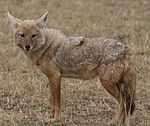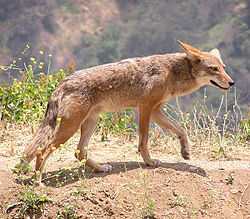Canis
| Canis Temporal range: Miocene to Recent 9–0Ma [1] | |
|---|---|
 | |
| Grey wolf and coyote (top), golden jackal and Ethiopian wolf (bottom) | |
| Scientific classification | |
| Kingdom: | Animalia |
| Phylum: | Chordata |
| Class: | Mammalia |
| Order: | Carnivora |
| Family: | Canidae |
| Subfamily: | Caninae |
| Genus: | Canis Linnaeus, 1758 |
| Species | |
1 C. lupus also includes domestic dogs, C. l. familiaris and dingos, C. l. dingo | |
Canis is a genus containing seven to 10 extant species, including the domestic dog, wolves, coyotes, and jackals, and many extinct species.

Wolves, dogs and dingos
Wolves, dogs, and dingoes are subspecies of Canis lupus. The original referent of the English word wolf, the Eurasian wolf, is called C. l. lupus to distinguish it from other wolf subspecies, such as the Indian wolf (C. l. pallipes), the Arabian wolf (C. l. arabs), or the Tibetan wolf (C. l. chanco), which are probably more similar to the variety of wolf that was ancestral to the modern dog (C. l. familiaris).
Some experts have suggested some subspecies of C. lupus be considered Canis species distinct from C. lupus. These include Central Asia's Himalayan wolf, and the Indian wolf, as well as the North America's red wolf and eastern wolf.
The dingo (C. l. dingo), from Australia, and the domestic dog (C. l. familiaris) are also considered subspecies of C. lupus, although they are not commonly referred to or thought of as "wolves".[2]
Coyotes, jackals, and "wolves"
C. lupus is but one of many Canis species called "wolves", most of which are now extinct and little known to the general public. One of these, however, the dire wolf, has gained fame for the thousands of specimens found and displayed at the La Brea Tar Pits in Los Angeles, California.
The dire wolf is an example of the word "wolf" being applied loosely, i.e., to a canid which is not C. lupus. Other examples include Canis simensis, which has undergone many popular name changes, as its intermediate morphology had caused some to think of it as a jackal or a fox, but current taxonomic and genetic consensus is reflected in its "official name", the Ethiopian wolf.
Canis species too small to attract the word "wolf" are called coyotes in the Americas and jackals elsewhere. Although these may not be more closely related to each other than they are to C. lupus, they are, as fellow Canis species, all more closely related to wolves and domestic dogs than they are to foxes, maned wolves, or other canids which do not belong to the Canis genus. The word "jackal" is applied to three distinct species of this group: Africa's side-striped (C. adustus), black-backed (C. mesomelas), and golden (C. aureus) jackals, which can be found across northern Africa, southwestern and south-central Asia, and the Balkans.
While North America has only one small-sized species, the coyote (C. latrans), it has become very widespread indeed, moving into areas once occupied by wolves. They can be found across much of mainland Canada, in every state of the continental United States, all of Mexico except the Yucatán Peninsula, and the Pacific and central areas of Central America, ranging as far south as northern Panama.
Etymology
The name Canis means "dog" in Latin. The word "canine" comes from the adjective form, caninus ("of the dog"), from which the term canine tooth is also derived.[3] The canine family has prominent canine teeth, used for killing their prey. The word canis is cognate to the Greek word kūon (Greek: Κύων) which means "dog".

Gallery
-

Gray wolf (Canis lupus)
-

Domestic dog (Canis lupus familiaris)
-

Dingo (Canis lupus dingo) (with familiaris as "domestic dog subspecies")
-

Red wolf (Canis rufus) (includes latrans admixture)
-

Eastern wolf (Canis lupus lycaon (often includes latrans admixture)
-

Dire wolf (Canis dirus) (extinct)
-

Ethiopian wolf (Canis simensis)
-

Golden jackal (Canis aureus)
-

Side-striped jackal (Canis adustus)
See also
References
- ↑ Canis Linnaeus 1758 in The Palaeobiology Database
- ↑ Wilson, D. E.; Reeder, D. M., eds. (2005). "Genus Canis". Mammal Species of the World (3rd ed.). Johns Hopkins University Press. ISBN 978-0-8018-8221-0. OCLC 62265494.
- ↑ Harper, Douglas. "canine". Online Etymology Dictionary.
